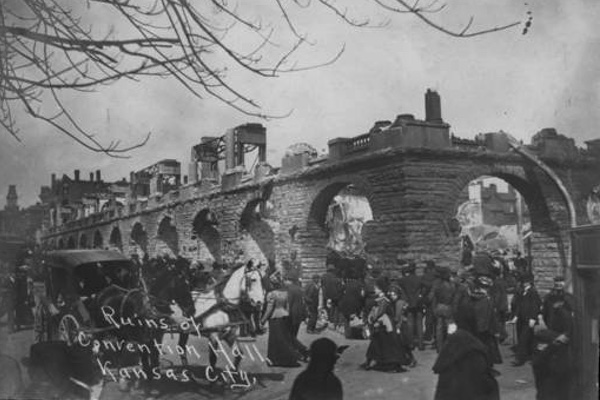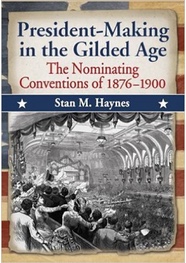Let’s Hold a Convention in … Cleveland?

The ruins of the Kansas City Convention hall, 1900
With the eyes of the political world focusing on Cleveland for the upcoming Republican Convention, the city will resume its role, for the third time, as a convention city. Conventions began during the campaign of 1832 . By the 1840s cities recognized the advantages conventions can bring, both in economics and civic pride. Then, as now, there was fierce competition for the right to host these quadrennial gatherings of the political parties.
 Baltimore
was the site of the first conventions and, from the 1830s to the
1860s, had a virtual monopoly on them. At the 1852 Whig Convention,
when a delegate proposed moving the next convention to Louisville,
another delegate was indignant, proclaiming, things had always gone
so well in Baltimore that “It is ungrateful on the part of any man
to move to change the place of meeting.”
Baltimore
was the site of the first conventions and, from the 1830s to the
1860s, had a virtual monopoly on them. At the 1852 Whig Convention,
when a delegate proposed moving the next convention to Louisville,
another delegate was indignant, proclaiming, things had always gone
so well in Baltimore that “It is ungrateful on the part of any man
to move to change the place of meeting.”
By the Civil War, Baltimore’s time in the spotlight had passed. With the nation’s westward-moving population, Chicago became the next convention city of choice. In 1884, when both parties met in Chicago, the Chicago Tribune praised the city’s hotels, transportation, and entertainment, crowing that they made “Chicago the Convention City of the future . . . [I]t will be unnecessary for small, inconvenient, hot, outside cities to put in any bid for the conventions. They will simply be located here as a matter of necessity and in accordance with the eternal fitness of things.”
But Chicago’s dominance also faded. Other cities were given opportunities to participate in the art of president-making, some with success and some without. Minneapolis landed the 1892 Republican Convention, but a reporter complained afterwards that while civic leaders had done their best, “they were badly handicapped in all their efforts by the fact that Minneapolis was never intended as a convention city and refused to be turned into one at the last moment.” Kansas City fared better, if for nothing else, triumph over adversity. Its new convention hall was selected to host the Democrats in 1900 but, in April of that year, three months before the convention, the hall burned to the ground. Astonishingly, the community built a new hall on the same site in less than ninety days, and the convention came off without a hitch. Civic leaders proclaimed “The Kansas City Spirit” to the entire nation.
Cleveland’s first turn in the political spotlight came in 1924, when the Republicans met in the newly-built Public Auditorium. More than 15,000 people packed into a building the New York Times called “the most beautiful as well as one of the largest public assembly halls” in the country. The convention was notable in several respects, being the first broadcast by radio and, with the passage in 1920 of the Nineteenth Amendment giving women nationwide the right to vote, the first to have open representation of both men and women as delegates. More than four hundred female delegates and alternates attended. President Coolidge had virtually no opposition to the nomination and, with little suspense over the outcome, a reporter noted that the convention was “long on efficiency and short on enthusiasm.” Silent Cal did not stir the passion of convention-goers. The convention, like its nominee, was viewed as dull. The fact that another recently enacted constitutional amendment, making prohibition the law of the land, was in effect, likely contributed to the somber atmosphere. Despite this, Coolidge won the election in a landslide.
The Republicans returned to Cleveland in 1936, to the same building. After gigantic losses in 1932 and 1934 to Franklin Roosevelt and the Democrats, the Republicans were then at low ebb, holding only small minorities in Congress and in governorships. There was a consensus as to their 1936 nominee but, as in 1924, little excitement at the convention. One of the few Republican officeholders to survive the Democratic deluge, Governor Alfred Landon of Kansas, easily won the nomination. Most of the speeches denounced the centralization of federal power under Roosevelt and the intellectual elite that ran his administration. In contrast, Landon was offered to the country as a man who was “unpretentious, unassuming, willing to serve—but not eager to dictate.” The Kansan won only two states in the election.
This year, the likely Republican nominee, Donald Trump, is the antithesis in personality to the staid Coolidge and Landon. He has promised to put “some showbiz” into the proceedings and, with some delegates still plotting a coup and with protests planned, Cleveland’s upcoming third convention promises to be anything but dull.